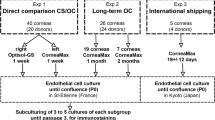Abstract
Background: The success of long-term corneal organ culture is limited by the progressive loss of endothelial cells during culture and the use of culture medium supplemented with fetal calf serum as a possible source of contamination with infectious agents. In this study, we investigated the suitability of a serum-free medium (Endothelial-SFM) to improve preservation conditions for human donor corneas. Methods: Six pairs of corneas were stored in Minimum Essential Medium (MEM) supplemented with 2% fetal calf serum (FCS) for 8–14 days. One cornea of each pair was then further cultivated in Endothelial-SFM supplemented with 2% FCS or in MEM with 2% FCS, respectively. In a second series of experiments, the endothelial cell density of seven pairs of freshly isolated donor corneas was determined during cultivation in Endothelial-SFM with 2% FCS or serum-free Endothelial-SFM. Results: After pre-cultivation in conventional medium, the endothelial cell density of corneas allocated to cultivation in Endothelial-SFM was 1000–1950 cells/mm2 and that of those subsequently cultured in MEM 1200–2000 cells/mm2. At 9 weeks, cell densities of 900–1500 cells/mm2 were found after cultivation in Endothelial-SFM compared with a total cell loss in MEM. Freshly isolated corneas cultured in Endothelial-SFM with or without FCS supplementation showed a decrease of endothelial cell density of about 20% within the first 2 weeks of storage. During further cultivation cell density remained constant without statistically significant differences between the groups. Glucose consumption of the corneas was higher in Endothelial-SFM than in MEM. Corneas stored in Endothelial-SFM with 2% FCS showed a higher glucose consumption than those preserved in serum-free Endothelial-SFM. Conclusion: Organ culture of human donor corneas using the serum-free basal medium Endothelial-SFM is superior to conventional culture conditions because the decrease in endothelial cell density can be ameliorated, the culture period can be prolonged and the risk of transmitting infectious agents via serum can be minimised.
Similar content being viewed by others
Author information
Authors and Affiliations
Additional information
Electronic Publication
Rights and permissions
About this article
Cite this article
Hempel, B., Bednarz, J. & Engelmann, K. Use of a serum-free medium for long-term storage of human corneas. Influence on endothelial cell density and corneal metabolism. Graefe's Arch Clin Exp Ophthalmol 239, 801–805 (2001). https://doi.org/10.1007/s004170100364
Received:
Revised:
Accepted:
Published:
Issue Date:
DOI: https://doi.org/10.1007/s004170100364




